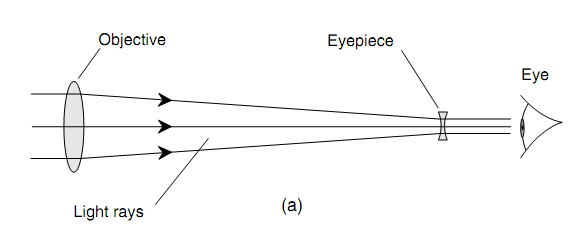Galilean Refractor:
The Galileo Galilei, the astronomer who became famed during the year 1600s for observing craters on the Moon and natural satellites orbiting Jupiter, developed a telescope having a convex-lens objective and a concave-lens eye-piece. His initial telescope magnified the evident diameters of far-away objects by a factor of only a few times. A few of his afterward telescopes magnified up to 30 times. The Galilean refractor (as shown in figure below) generates an erect image, which is, a right-side-up view of things. Additionally to appearing right-side up, images are also accurate in the left-to-right logic The magnification factor, defined as the number of times the angular diameters of far objects are raised, based on the focal length of the objective, and also on the distance among the objective and the eyepiece.

Figure: The Galilean refractor uses a convex objective and a concave eyepiece.
The Galilean refractors are available nowadays mainly as novelties for terrestrial viewing. The Galileo's unique refractors had objective lenses only 2 or 3 cm (around 1 in) across; the similar is true of most Galilean telescopes nowadays. Some of these telescopes have sliding concentric tubes which provide changeable magnification. If the inner tube is pushed all the way into the external one, the magnification factor is the lowest; whenever the inner tube is pulled the entire manner out, the magnification is highest. The image stays pretty clear over the whole magnification-adjustment range. Such instruments are sometimes termed as spyglasses.